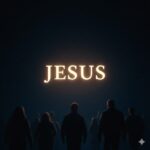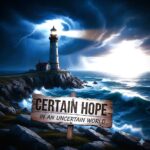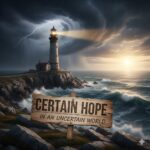“Above All Else : Humanity” – Romans 6:23
1. God’s Image
Today, we are getting back to a series of sermons on the essentials of our Christian faith – what we believe and how we live because of what we believe. We have already looked at the three Persons of the Godhead – Father, Son, and Holy Spirit. Today we turn our attention from heaven… back to earth, as we consider own humanity.
When we looked first at God the Father, the Creator, we acknowledged, with Martin Luther, that God made me, that He preserves, provides for, and protects me. Let’s expand our understanding of God creating human beings by pulling out from Genesis 1 a profound theological concept and phrase. There we read that God created male and female “in His own image.” That first chapter of the Bible does not define what characteristics the “image of God” includes, but we gain an understanding from the context, and also from other passages of Scripture. We have no idea if “image of God” refers to a physical resemblance, but we do have a sense that it includes qualities of the intellect, the heart, and the will. The divine image means having a knowledge, righteousness, and holiness similar to that of God. Our first parents, Adam and Eve, were created without sin, they knew God personally, and they were perfectly happy in Him. They were devoted to what is right and God-pleasing, and they had a deep understanding of God’s will. Besides all that, they were created with an eternal soul in their DNA.
2. God’s Image… lost
But it didn’t take long for that “image of God” to be lost. When tempted by Satan, in the form of a serpent, to disobey the one restriction in the Garden of Eden, both Eve and Adam rebelled against God’s good and righteous will, and they chose to sin of their own free will. That first act of disobedience brought disastrous consequences. Relationships were broken. Their relationship with God was broken in the mere act of disobedience, which led to fear and shame before God. Their relationship with each other was broken, as evidenced by the blame game… something that still runs rampant in relationships in our time. Their relationship with nature and the environment was broken – there would be thorns and thistles, and they would have to work sweaty hard to eat their food. Besides all that, they would now experience death, just as God’s original warning had said. Oh sure, they retained some characteristics that distinguish them / us from animals – intellect, reason, speech, conscience, and the soul. But in that fall into sin, humanity lost its most precious possession – the divine image, and the ability to know and please God. In Christ, that image is being recreated, but it will only be fully restored for us in heaven.
3. Sin
a. The Nature of Sin
As we consider humanity, and the lost image of God, it is important to clarify the nature of sin. What is sin? Briefly, sin is the violation of God’s will, the willful rebellion against the majesty of God, the simple disobedience of God’s Law. Every thought, desire, word, and action that is contrary to God’s Law is sin. Bible words depict three different images of what sin is.
One of those images is trespassing, and here you would imagine a sign on someone’s property that simply says “No Trespassing.” In other words, “Don’t set foot on my property.” Or you might think of that yellow line on the platform of the train station. Silently it communicates “Don’t cross this line… for your own good, don’t cross this line!” Our common version of the Lord’s Prayer pleads, “Forgive us our trespasses.” It’s not the trespasses of crossing the yellow line or walking onto someone’s property without permission. It refers to the times when we have boldly gone where God doesn’t want us to go.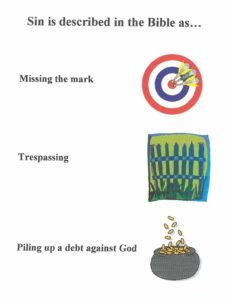
A second Biblical image of sin is “missing the mark.” Here you can imagine a target for a bow and arrow, with the bull’s eye being perfect love for both God and our neighbor. Unfortunately, and being honest with ourselves, we do have to admit that not only do we fail to hit the bull’s eye with 100% love, but we often miss the target completely. That’s sin!
A third Biblical image of sin is the concept of amassing debt. That was illustrated by Jesus’ Matthew 18 parable of a servant who owed his master, the king, a debt of ten thousand talents – a 1st century measure of money. I have done the calculations of what that would be in modern terms, and it’s something like 200,000 years’ wages!! The parable was told in the context of the subject of forgiveness, so because Jesus described it as a Kingdom of Heaven parable, we truly understand it to talk about the debt of sin that we owe to God, our King.
I really appreciate the thoroughness of the confession of sins in one of the services from our hymn book, when it says, “We have sinned against You in thought, word, and deed, by what we have done and by what we have left undone. We have not loved You with our whole heart; we have not loved our neighbours as ourselves.” That means sin is both committing wrong things, and omitting good and right things. It refers to offenses against God, and offenses against our neighbor. That’s the nature of human sin. But there’s more…
b. Original Sin and Actual Sin
There are two kinds of sin. Actual sin we can easily understand – it’s the things that we say and do that are wrong. The second kind of sin is original sin. Let me explain that with a couple of illustrations:
You can’t expect a human father and a human mother to give birth to a… platypus!! That’s ridiculous!! In the same way, you can’t expect a SINFUL human father and a SINFUL human mother to give birth to a spiritually HOLY and PERFECT child. No! It’s just not in their DNA. Sin is passed down by heredity, from parent to child. There’s no escaping it. A sinful father and a sinful mother just automatically give birth to a sinful child. King David, in Psalm 51, wrote that he was sinful at birth… in fact, even from the time his mother conceived him. That’s original sin.
A second way to look at original sin is with this diagram of a tree. 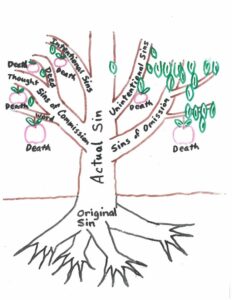 The actual sins are the part of the tree that you see – thoughts, words, deeds, commission, omission, intentional, unintentional. That’s obvious. But the part of a tree we can’t see is the root. It’s the heart of what the tree will become. In the same way, original, inherited sin is not seen, but it’s there as the root cause of why we sin. Even if you consider an infant to be innocent and holy and sinless, original sin is still there waiting to show itself in actual sins. After all, have you ever considered that you don’t need to teach a child how to sin? They seem to know how to sin all on their own!!
The actual sins are the part of the tree that you see – thoughts, words, deeds, commission, omission, intentional, unintentional. That’s obvious. But the part of a tree we can’t see is the root. It’s the heart of what the tree will become. In the same way, original, inherited sin is not seen, but it’s there as the root cause of why we sin. Even if you consider an infant to be innocent and holy and sinless, original sin is still there waiting to show itself in actual sins. After all, have you ever considered that you don’t need to teach a child how to sin? They seem to know how to sin all on their own!!
One last thought here… and that is that sin is universal. Everyone is a sinner, and everyone sins. Listen to this description of people in Noah’s time: “EVERY inclination of the thoughts of human hearts was ONLY evil ALL THE TIME!!” That’s all-encompassing!! So is Paul’s assessment of things in Romans 3. He wrote: “There is no one righteous, no one who does good, not even one… all have sinned and fall short of the glory of God.”
c. The Results of Sin
Those are all pretty sobering thoughts, but then we have yet to consider the results of sin. We can go back to the Garden of Eden and hear God’s initial restriction and result: “In the day that you eat of the tree of the knowledge of good and evil you shall surely die.” Romans 6:23 puts it just as bluntly… “The wages of sin is death.” So, if we look back at that tree of sin, we can now notice that on every sin branch there is the fruit of death.
Since I have already made a veiled reference to Star Trek, I will draw another more obvious analogy. In the second star trek movie, The Wrath of Khan, Captain Kirk of the starship Enterprise had apparently been responsible for the death of the wife of a super intellectual Khan. He had been waiting for 15 years to avenge his wife’s death, and in the movie he had finally been able to encounter Kirk again and to exact the fullness of his wrath, which actually resulted in the death of Kirk’s closest friend, Spok.
While not a movie, and not exactly a plot about revenge for a grievous wrong, the Bible does describe the wrath – not of Khan, but of God. Sin arouses the wrath of God. We might think that wrath is contrary to the nature of God, who is love, and mercy, and grace. But God is also righteous and just, and when His will has been violated, God’s justice requires that the offender be subject to the wrath of the Lawgiver. That wrath includes both physical and eternal death and separation from God. [But please wait for a moment… because that’s not the end of the story, just like Spok’s death was not the end of the Star Trek story.]
Other results of sin impact the brokenness in human relationships and brokenness with respect to our environment. In human relationships you see the results of sin in lies, and greed, and self-centeredness, and harboring grudges, and bullying, and taking advantage of others who are more vulnerable, and broken marriages, and run-away children, and hatred, and murder, and… well, the list goes on and on. With respect to the environment, the brokenness of sin hasn’t just led to thorns and thistles but to volcanoes and earthquakes and floods and heat domes and tornadoes and pollution and ozone holes and shrinking polar caps and… well, that list goes on, too. That might not make sense to you, but in the beginning God created everything VERY GOOD, and when Adam and Eve brought sin into the world, nothing was VERY GOOD anymore, and everything was broken. How very sad that is, and we all, by our own sinfulness, contribute to that brokenness.
4. Three Purposes of the Law
One more quick thing about the Law, which is kind of like a cousin of sin. The Bible describes three purposes of the Law. First, the Law helps to control violent outbursts of sin and keeps order in the world. This use of the Law is as a curb or fence… kind of like the “No Trespassing” sign, or maybe a “No U-Turn” sign. It’s there for our good, to protect us from a dangerous driving situation. As a curb, the Law says to us “Go here! Don’t go there!” The first example of that in the Bible was God’s command to Adam, “Don’t eat of that one tree!”
The second use of the Law is as a mirror. It tells us what sin is and shows us our sin. But let me save that one for a minute, and get to the third use of the Law… as a guide. In this case, the Law teaches us Christians what we should and shouldn’t do in order to lead a God-pleasing life. It’s found in advice like: “Speak the truth in love,” and “Love your neighbor,” and “Be kind and compassionate,” and “Forgive whatever grievances you may have against one another.” Those are ways that God is saying, “This is how I want you to live in relationship with others.”
Now back to the use of the Law as a mirror. You know how sometimes when you look in the mirror you see some lettuce or some other piece of food in your front teeth? The mirror helps you to realize that your facial appearance is flawed. It shows you your appearance “sin.” God uses the Law in the Bible to show you the lettuce not in your teeth, but in your heart, in your moral / spiritual appearance. It shows your sin. If people didn’t realize that stealing and adultery and murder were displeasing to God, there would be a WHOLE LOT MORE evil in our world. But the Bible tells us. Especially the Ten Commandments tell us.
We’re actually going to pause here and take a few moments to use the Ten Commandments as our confession of sins today, followed by the song, “Lord, Have Mercy.” Please stand…
The Ten Commandments
- We confess that we have not feared, loved and trusted in God above all things.
- We confess that we have not called upon God’s name in every trouble, nor have we appropriately prayed, praised and given thanks to Him.
- We confess that we have not held God’s Word sacred, and gladly heard and learned it.
- We confess that we have not honoured, served, obeyed, loved and cherished our parents.
- We confess that we have not helped and supported our neighbor in every physical need.
- We confess that we have not lived a sexually pure and decent life, loving and honouring our spouse as God intends.
- We confess that we have not helped our neighbour improve and protect his possessions and income.
- We confess that we have not defended our neighbor, nor have we spoke well of him, nor explained everything in the kindest way.
- & 10. We confess that we have not encouraged our neighbor in the keeping of both house and spouse.
5. Three Purposes of the Law
We’ve heard a LOT about sin today, and I’m sorry if that has discouraged and disheartened you. It’s real and true and we need to hear it. But just like the death of Spok in the Star Trek movie was not the end of the story – if you saw the next movie, you’ll remember… his casket got jettisoned off the Enterprise onto a planet called Genesis, which created plant life AND which also just happened to resurrect Spok… yes, RESURRECT!! – just like that story, sin and death are not the end of our story. In fact, what we heard earlier from Romans 6:23 is not the end of the verse, not the end of the story. “The wages of sin is death” – yes, “but the gift of God is eternal life in Christ Jesus our Lord!”
God sent His Son Jesus to live a very human life, with one dazzling difference – Jesus was without sin. He didn’t have to experience the wrath of God because of sin! But He did!! For you!!! And me!!! Sin created a humanly unbridgeable chasm between God and us.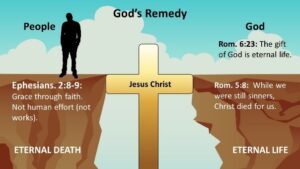 Jesus’ sacrifice of Himself bridges the chasm between God and us that sin has created. He has begun that process of recreating the image of God within us that was lost in Eden, and with His cross He makes a path from one side of that chasm back toward a meaningful and blessed relationship with God our Father. Jesus is the remedy for sin, the remedy for YOUR sin. With His cross, and with His resurrection He boldly declares what no man has been able to declare before: “You are forgiven! You are God’s child! You are saved! You can spend eternity with God just as He had purposed from the very beginning.”
Jesus’ sacrifice of Himself bridges the chasm between God and us that sin has created. He has begun that process of recreating the image of God within us that was lost in Eden, and with His cross He makes a path from one side of that chasm back toward a meaningful and blessed relationship with God our Father. Jesus is the remedy for sin, the remedy for YOUR sin. With His cross, and with His resurrection He boldly declares what no man has been able to declare before: “You are forgiven! You are God’s child! You are saved! You can spend eternity with God just as He had purposed from the very beginning.”
6. How we live in relationship
And that leaves us with just one more thing… How, then do we live as human beings in relationship with one another. This is where the third use of the Law comes in… as a guide to leading a God-pleasing, Christ-like life. As a forgiven and saved child of God we can joyfully live out some of those things I mentioned before: “Speak the truth in love;” “Love your neighbor;” “Be kind and compassionate;” “Forgive whatever grievances you may have against one another.” Add to that some other Biblical relationship gems: “Do unto others what you would have them do to you;” and “Share with God’s people who are in need;” and “Honour one another above yourselves.” Add to that the Fruit of the Spirit… you can see them on the banners today: love, joy, peace, patience, kindness, goodness, faithfulness, gentleness and self-control. Those are ways that God is saying, “This is what it means to truly be human. This is how I want you to live in relationship with others. And I’ve given you my Spirit to guide and bless and fill you with that genuine desire. I’ve given you my Spirit so that you can always call me ‘Abba, Father.” Amen.




